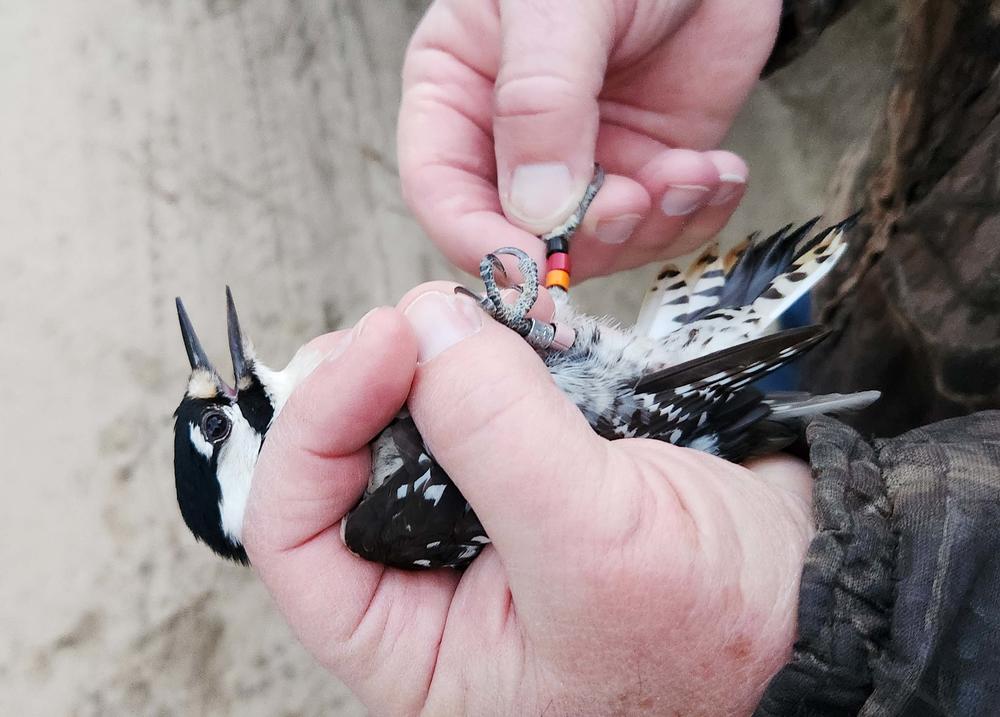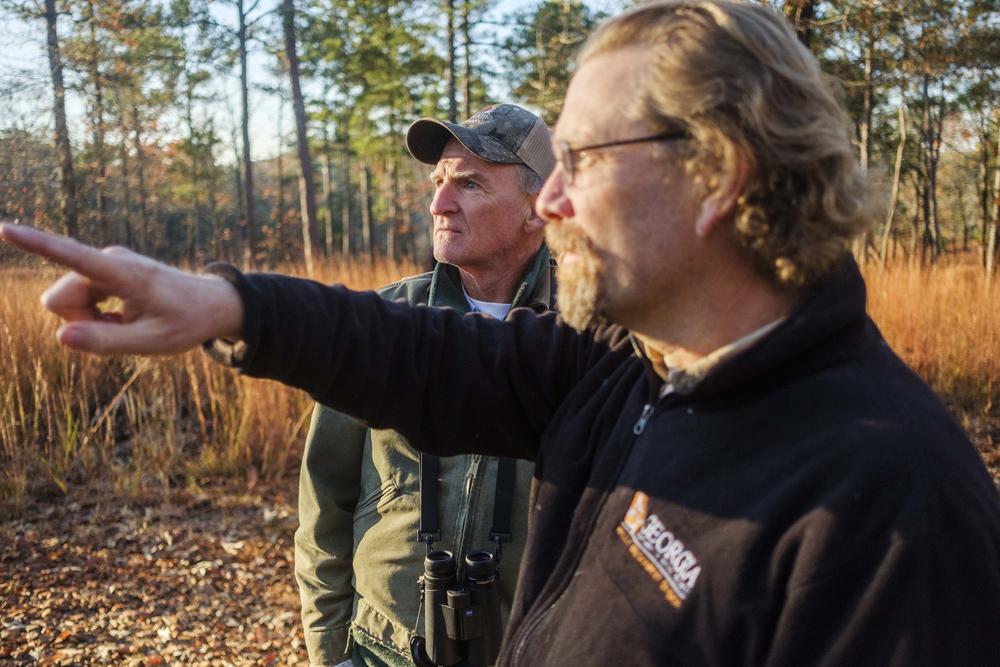
Caption
Georgia Department of Natural Resources biologists, including Joe Burnam (right), install human-made nesting cavities for red-cockaded woodpeckers on Sprewell Bluff in October.
Credit: Grant Blankenship / GPB News
The Flint River was hidden and dark in the predawn hours below the entrance to Sprewell Bluff Park in Upson County, where people with birding scopes and sturdy shoes had gathered, some from hours away.
Then, as he had done dozens of other times with other teams, Georgia Department of Natural Resources Senior Biologist Nathan Klaus asked the group to focus on their shared goal for the morning.
"So thank you very much for being here," he said. "You know, you all know how much I value the role that you played, each one of you, in getting us to this place."
The "place" was more a goal, or an ecology, that Klaus had been working toward for 20 years: the release of six federally endangered red-cockaded woodpeckers into the pine savanna just downhill from here.
In a world seemingly broken by human activity, human activity can be the only thing to set things right again, at least in the short term. That’s the spirit of wildlife conservation and the Endangered Species Act, which turns 50 this year.
But the irony is that what is short-term to the Earth can span a human career, even a lifetime. Rarely do conservationists get to see the whole picture themselves.
That’s the real reason why Nathan Klaus was surrounded by colleagues and loved ones for the release of the birds.

Georgia Department of Natural Resources biologists, including Joe Burnam (right), install human-made nesting cavities for red-cockaded woodpeckers on Sprewell Bluff in October.
It took 20 years to get these red-cockaded woodpeckers to Sprewell Bluff because first Klaus and others had to sculpt the right kind of forest.
Joyce Klaus is Nathan’s wife and a wildlife scientist, too. And she said when he first brought her to places like Sprewell Bluff, they weren’t much to see, at least to the ecologically informed eye.
“When Nathan and I were first dating — that would have been 17 years ago — some of the places he brought me to that he was working on, I was just like, ‘Oh, that's nice, honey,’” she recalled, laughing.
Nathan remembers those days, too.
“The first photograph I have, it's a wall of sweetgum,” Nathan Klaus said.
Sweetgums are the hardwoods that are the first to take over from pine trees in a Southern forest. But red-cockaded woodpeckers absolutely require mature, living pines for nesting. The sweetgums absolutely had to go, so Klaus and a rotating cast of teammates got to work with a very old tool.
They brought the fire.

A prescribed burn at Sprewell Bluff in 2019.
Fire had been on the Southern landscape for hundreds of years prior, either set intentionally or left to run its course by Indigenous people, before Europeans suppressed it.
Longleaf pine savannas once dominated the Southern coastal plain from Texas to Virginia. In Alabama and Georgia, there were huge stretches of Piedmont, or montane, savannas, too. That’s the Sprewell Bluff part of the world. Today, largely because of fire suppression, the ecosystem only occupies about 3% of its former range.
As woodpeckers need pines, pines need fire. Every other year for the past two decades, Klaus and a crew under his direction would set fires which killed hardwood saplings and encouraged pine tree germination.
That’s the science behind prescribed fire. But Joyce Klaus says to burn a forest well takes more than science.
"It's a lot of art, too," she said. "And it's kind of like being a landscape artist. Which is pretty cool."
Earlier this year, U.S. Fish and Wildlife agreed the Sprewell Bluff landscape looked right. They greenlit the capture of six birds from their old forest, at the Army’s Fort Stewart in South Georgia.
That involved even more collaborators, expert in sneaking up on woodpecker nesting cavities with what look like the world’s largest butterfly nets. In a video after the capture, one bird vocally expressed displeasure.

One of six red-cockaded woodpecker birds relocated from South Georgia's Fort Stewart to Sprewell Bluff in the western part of the state is handled.
They were driven through the night to get here yesterday, all reasons why Nathan Klaus asked people to quietly sneak down the gravel road to the release site.
“You want to give them their space," he said. "They've already been through basically an alien abduction, you know?”
So why subject an endangered bird to this in the first place? Bob Sargent, another Georgia DNR biologist, said it’s about mitigating risk.
“Well, you know, this is a case of not all your eggs in one basket, right?” he asked.
In this analogy, the eggs are actually birds. The basket is South Georgia where most of the the state’s red-cockaded woodpeckers live.
“And of course, with concerns about issues such as climate change, now we have an increase in the number of hurricanes, for instance, coming up through the Gulf,” he said.
Hurricane Michael came from the Gulf of Mexico in 2018 before it leveled forests in Southwest Georgia and the Florida panhandle. Endangered woodpeckers likely lived in some of those trees.
“You can lose a lot of cavity trees and a lot of clusters all at once,” Sargent concluded.
That’s why red-cockaded woodpeckers may be safer further inland in the future.

Retired Georgia DNR biologist Jim Ozier (left) and Nathan Klaus converse after the release of relocated endangered woodpecker birds in a new habitat.
All manner of lenses were trained on Klaus and Luann Craighton of the Nature Conservancy (which helped purchase much of this western Georgia land) as they held ropes running up the trees to metal screens over the woodpecker’s holes. When they pulled the ropes, the holes were opened to the rising sun.
The woodpeckers chirped so loudly they could be heard even 50 yards away. After being answered by one or two other woodpecker species already living nearby, the birds bolted out of sight, a first success. Real success will come in two weeks when Nathan Klaus knows if they have come back.
Once the scopes and binoculars came down, the mood was celebratory if still pretty subdued in the group that lingered at the site.
Among them was Jim Ozier, a retired Georgia DNR biologist who spent what he called “40ish” years in a career which, among other things, laid the groundwork for the end of a half century of the red-cockaded woodpeckers’ absence from Sprewell Bluff.
“I dreamed it,” Ozier said of the birds in flight, again, at this place. “But I didn't think I'd see it.”
There was still some question as to whether or not the birds would stick around, or look for some better place. That would have been a setback.
A few weeks after the release, Nathan Klaus and others checked the tree boxes again. What they saw put those fears to rest.
The woodpeckers had stayed. Klaus said what followed was jumping up and down. Hugs. Celebration.